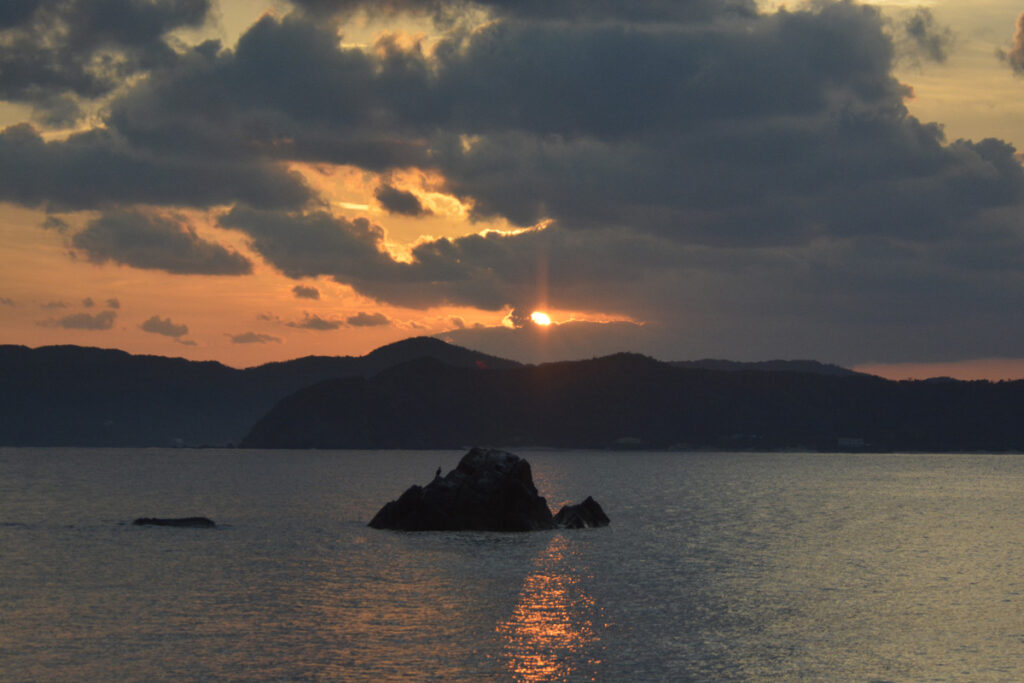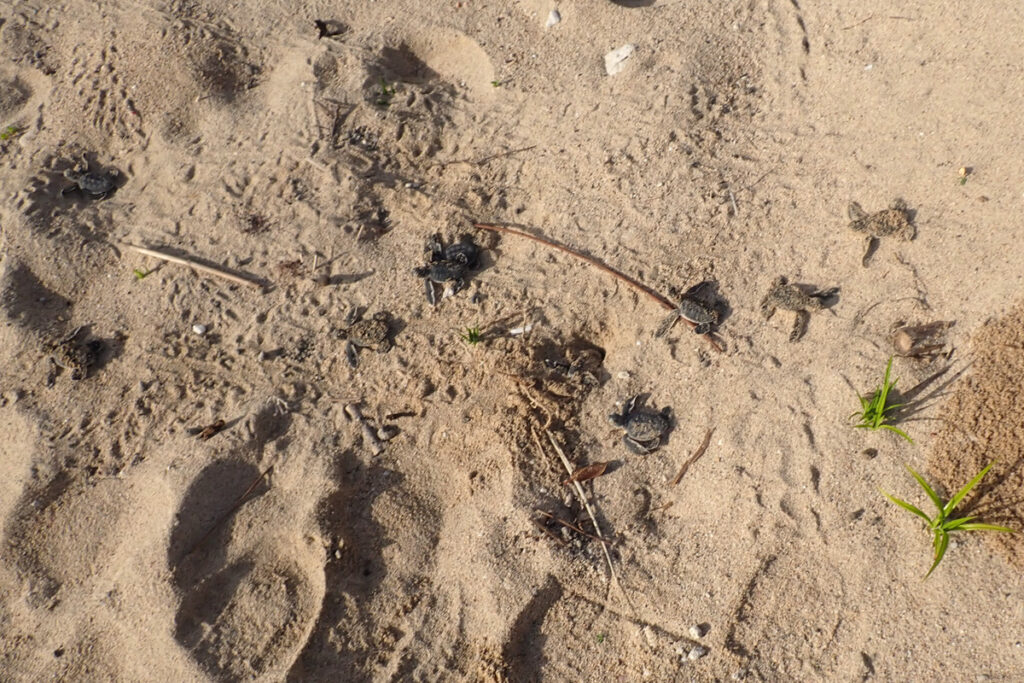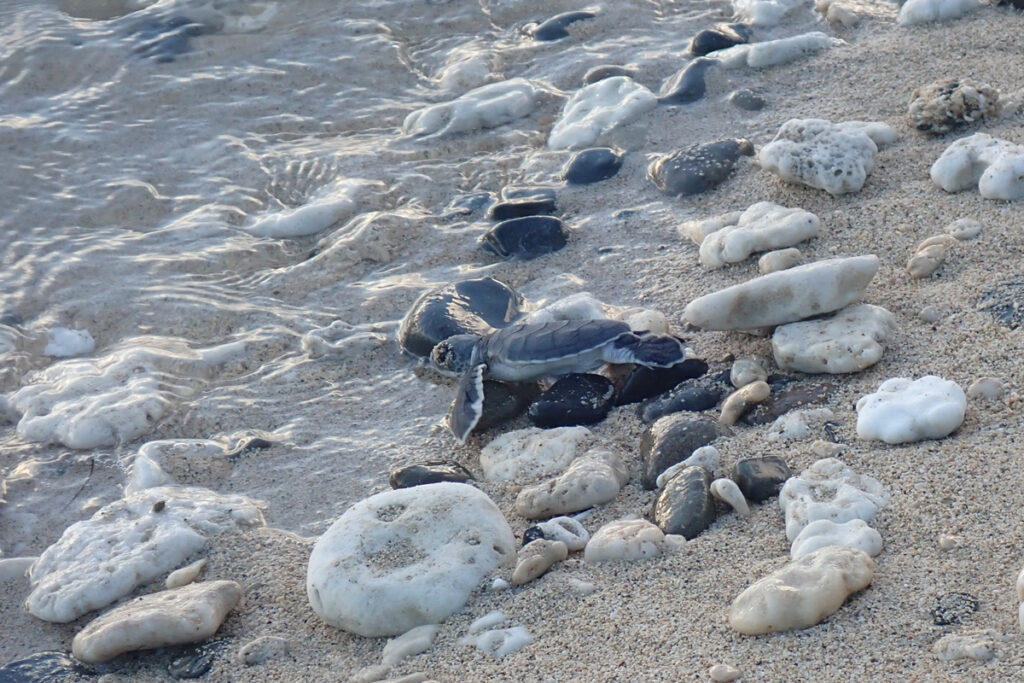
This is a Green Sea Turtle. I have been seeing them for over 40 years now. This one was in the surge zone feeding on algae. Kauai 2014

Here are several turtles grazing on algae in the surge zone. Algae grow good in the surge zone. Kauai 2015

Turtles are marine reptiles that do need come up to breath occasionally. Kauai 2010

They can sleep underwater too. They do come up in the night for air. Kauai 2011

Turtles will hit the beach for a nap too. Hawaii 2017

When the waves pick up at Milolii lots of turtles rest on the beach. There are 13 in this picture. Kauai 2011

Turtles mating in the ocean. Kauai 2005
This brings me to the point of the turtle project. I had never seen turtles nesting or baby turtles hatching. I wanted to see and photograph baby turtles racing down to the ocean.
Near my house there is a beach where I saw turtle nests. Turtles like to nest and hatch at night. This makes it hard to photograph in the dark. It is also hard to see and not disturb the turtles at night.
My plan was simple. I would walk the beach about sunrise every morning in the spring and summer. I would look for turtle nests and then later I would look for signs of hatching. If I saw any signs of hatching, I would look for stragglers. I would help the stragglers and photograph them.

I would see a lot of sunrises on this plan. Amami 2024

First day of nesting during the project. Finding turtle tracks and nests is not hard to do. There were several nests and two sets of tracks out of the water and two into the water. I am thinking it was two turtles. It is possible that one turtle made two trips also. I had heard that they nest on full moon nights. The moon was close to half rising at 00:20 that morning.

More turtle tracks from the same morning. There are many signs of stopping and digging. Many of the nesting attempts were in areas of vegetation. I think that if the turtle doesn’t find a suitable site that it just moves on. Vegetation encroaching on suitable nesting sites is a problem for turtles.

The next morning the moon rose at 01:19. I did not see that but, I did see a turtle in a nest. It was still digging so I found a good place to see it without disturbing it. It was digging with its front flippers at first. Later it switched to its back flippers for the egg chamber. After a while it started filling with its front flippers before leaving. I could not see the eggs dropping. The picture above is of the turtle leaving the nest. This was the only turtle nesting that night. There were now about 12 nests that looked like they should have eggs.

The turtle heading back to the ocean. The tracks on the beach are hard to miss.

There was a bit of waiting until the next event. I would check the nests for any activities look at the tracks on the beach. These are from large hermit crabs.
From what I was able to find, it takes about two months for Green Sea Turtles to hatch. With a range of from 50 to 70 days.

I often saw tracks of wild boar on the trail to the beach. Sometimes I would hear them and a couple of times I was able to see them. Fortunately, I was not seeing their tracks on the beach. They could wipe out a turtle nest overnight. They have also been known to raid turtle nests.

The trail to the beach after a heavy rain. I was able to go check the beach almost every day. There were a few rain delays and sometimes I would have to use alternate paths to the beach. There were some days that I just did not go due to the weather.

June 14 there was a new set of turtle tracks and a nest site. These tracks were not made by a Green Sea Turtle. The flipper marks alternated. Adult Green Sea Turtles use both flippers at the same time.

The trail was a little wet on this morning. I was able to get some pictures of this Pryer’s Keelback on the path through the stream.

88 days since I saw the turtle laying eggs, I started to see snake tracks on the beach. There are sea snakes here as well as land snakes. The sea snakes also lay eggs on land.
Still no signs of turtles hatching. The depression behind the snake tracks is a turtle nest.

104 days since I saw the turtle laying eggs, I saw the front of a snake sticking out of the same nest. It was a Ryukyu odd-toothed snake. It was the first time I had seen a live Ryukyu odd-toothed snake (Akamata). I had seen dead ones in the road before. This is also the first look at a baby sea turtle too. It was not the experience that I had expected. Only a little bit of the snake was sticking out of the sand and only a little bit of the turtle was sticking out of the snake. Nature is not always pretty. Snakes have to eat too. The Akamata is not venomous. They eat the venomous habu, lizzards, frogs baby sea turtles and other small creatures. I let it eat the turtle in peace.

After eating the baby turtle the akamata put its head back in the sand and came out with another.

The turtle was still putting up a fight and I decided to put the camera down and give the turtle a hand. I shooed the akamata away. It left with three bumps in it which I thought was enough for breakfast. The turtle in the two above pictures was dropped and was able to run down to the ocean and swim away.

I started to dig where the akamata was and found more baby turtles. I carefully dug them out and let them run down to the ocean on their own. There were no birds or other predators on the beach to attack them.

The baby turtles ran down the beach faster than I thought they would.

A total of 19 baby turtles made it from the nest to the ocean that morning while I was there. The next day I found 2 more that I dug out of the sand and let run to the ocean. On this second the next nest down the beach was all dug up with footprints around it. There were also a lot of other footprints going back and forth to the ocean. I think someone else was rescuing turtles there. There was usually only one or two sets footprints on the beach every day. I had wondered if they were looking for turtles too.

The high tide line slowed the turtles down a bit, but they were able to get past it.

On day 106 of the nest the akamata was digging again. I watched it to see if it could find any more turtles. It found one and took off with it in its mouth. You can see the bumps from turtles two days earlier. The akamata kept coming back every day for over a week. I didn’t see it get any more turtles, and I couldn’t find any more turtles in this nest. I think that if it wasn’t for the snake I would probably not have found any in this nest.

About a week later I saw baby turtle tracks on the beach and followed them to a nest that was 86 days old. I dug around and found a dead baby turtle. A little more digging and I found 7 live baby turtles. They all ran down the beach well but 2 swam in circles in the water. There were lots of tracks on the beach so I think that most of them made it to the water all on their own.
I watched the one nest that was an unknown species of turtle until a typhoon eroded the beach around it. The beach changed a lot during that typhoon with strong onshore wind and waves at this beach. It also killed a lot of the vegetation that was encroaching on the beach. I hope that next summer the conditions are good for the turtles.
